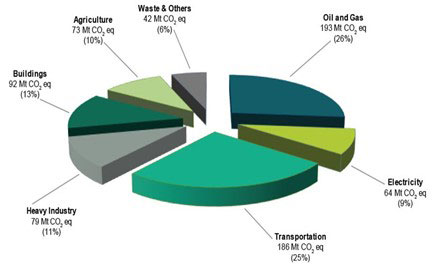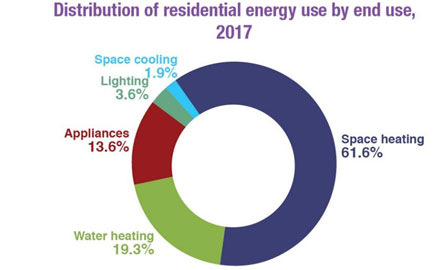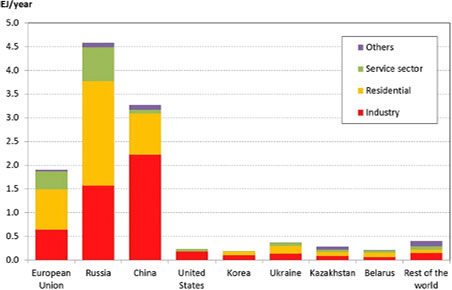Ground-source heat for district energy: using the Earth to decarbonize heating
As the world focuses on reducing carbon emissions through the electric vehicle market and finding renewable alternatives to power production, one contributor of greenhouse gases (GHGs) gets overlooked: buildings. In order to meet the commitments under the Paris Agreement, Canada and the rest of the world need to place equal importance on reducing all sources of emissions.
GHG emissions that stem from businesses and homes are primarily caused by fossil fuels burned for heat. As seen in Figure 1, emissions from buildings are the third-largest source of emissions in Canada. Canadians tend to use more energy for heating and cooling due to our dispersed population and seasonal temperature fluctuations.

Figure 1: Breakdown of Canada’s Emissions by Economic Sector1
When looking specifically at residential energy consumption in Canada, 83% is used for the heating/cooling of domestic space and water. Figure 2 shows a breakdown of the main sources of energy consumption in a Canadian home. Energy use in buildings is the third-largest emitter globally, contributing approximately 18% of total GHG emissions worldwide, of which half can be attributed to heating and cooling. Consequently, the transition to a low-carbon future largely depends on decarbonizing the energy consumption required for heating and cooling.

Figure 2: Residential Energy Use in Canada2
Ground source heating—which includes stored solar energy that can be utilized for heating and cooling—is capable of replacing the fossil fuels currently being used. While some critics believe that Canada isn’t ideal for geothermal systems due to its low amounts of geothermal activity, when it comes to direct use of heat, geothermal resources are not required to be quite so hot. Stored solar energy that can be found underground just four meters deep is sufficient for heating buildings.
Ground source heat pumps (GSHPs) use the ground, groundwater, or surface water as a source and sink for heat. GSHP systems can absorb or reject heat from the ground through a heat exchange system called the ground loop. Via the heat pump, the indoor air exchanges heat with the fluid running through the ground loop. Although geothermal energy can’t be considered 100% clean energy (the heat pumps may be using electricity produced by fossil fuels), heat pumps reduce carbon emissions as there is no combustion involved and no flue gases emitted. As such, GSHPs for district heating are a key technology to decarbonize the heating sector and reduce the dependency on fossil fuels.
When looking at district heating around the world, Europe, Russia, and China lead the way. Geothermal heat resources have been used in district heating applications for many years, with Europe currently spearheading the market. There are over 5,000 district heating networks in Europe, located mainly in Western and Central Europe and in Scandinavia. Out of the 5,000, only about 280 use geothermal energy. From all European countries, Iceland was the country to produce the largest volume of geothermal-sourced district heat by far, followed by France, Germany, and Hungary. Reykjavik has the world's largest and most sophisticated geothermal district heating system, using natural hot water to heat the city’s buildings and homes since 1930. The Icelandic government has played a critical role by providing numerous loans and grants.

Figure 3: Main Users of District Heating3
In Canada, Mattamy Homes and Enwave Energy Corporation have built a 300-home community in Markham, Ontario—the largest of its type in the country—that will use a district geothermal system for heating, cooling, and domestic hot water. Hatch acted as technical advisor on the GSHP system as the project approached detailed design in 2020. To support this initiative, The Atmospheric Fund awarded a grant of over $225,000 over two years to the City of Markham to research, coordinate, and design initial concepts for a net-zero neighborhood anchored by a district geothermal system. Hatch can assist in feasibility studies, planning, engineering, and setting up a business case for those looking to make use of geothermal energy in district heating applications.
Although geothermal heat as a resource is free of cost, there are high upfront costs associated with using it. Typically installing GSHP systems can be very expensive for an individual household or building. However, economies of scale when implementing these systems in district heating applications by serving multiple existing homes or a community enable more affordable and widespread use. Another benefit is that portions of the pipes for these systems can be buried horizontally as opposed to vertically underground, which can further reduce costs as vertical drilling is expensive. Ultimately, savings in energy and maintenance costs in the long run offset the upfront expenses.
Utilizing ground source heat to provide heating and cooling to customers in district heating applications is possible for new developments if sufficient planning is done ahead of time to integrate these systems into the design, supportive policies by the government are implemented, and if grants are made available to help advance geothermal community energy systems.
Learn more here.
References:
1 Government of Canada, "Greenhouse gas sources and sinks: executive summary 2020", 2021,
2 Government of Canada, Natural Resources Canada, “Energy Use in the Residential Sector”, 2021,

Catherine Roy
EIT, Thermal Power
Catherine Roy is a part of Hatch’s thermal power business unit and partakes in business development and thermal energy projects. As a part of the team, she has performed due diligence and feasibility studies and has had exposure to a wide range of technologies such as combined cycle and cogeneration power systems, gas and steam turbines, district energy systems, and geothermal energy including ground source heat exchange.